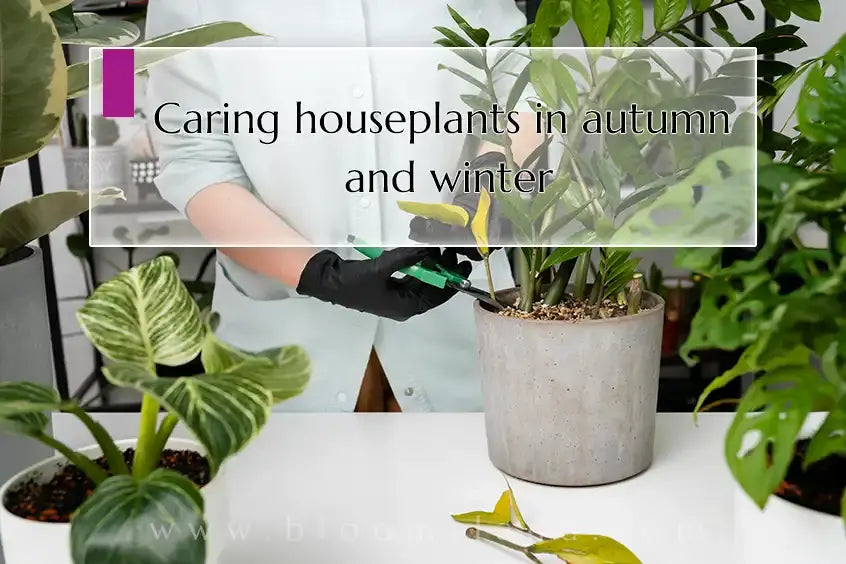
Caring Houseplants in Fall and Winter
As the season changes and cooler temperatures arrive, it’s important to adapt your home plant care routine to meet their specific needs. Caring for houseplants in the fall and winter requires extra attention, but the rewards are well worth it. In this guide, we’ll explore the complexities in the nutrition of your green indoor companions, providing insights tailored to the Australian climate.
Essential houseplants care practices for fall and winter
Navigating the transition between fall and winter requires thoughtful adjustments to your houseplant care routine. During these colder months, vigilance is paramount in managing water consumption. Houseplants generally don’t need a lot of water, and it’s important that the topsoil is drained before you consider watering again. Balance maintaining optimal lighting conditions with accepting reduced daylight hours. Strategically place your plants near bright windows, to ensure they get the sunlight they need. Consider adding artificial light for plants that live in dark areas. In addition, be mindful of temperature fluctuations and protect your plants from drafts and drastic changes. By following these important care practices, you are giving your green roommates the best possible conditions to thrive during autumn and winter in the Australian climate.

Expert advice for those interested in delivering flowers
Incorporating Flower Delivery into Home Decor? Embrace the beauty of seasonal blooms with the help of florists offering flower delivery services. Arrange a stunning bouquet to complement your houseplants, adding a touch of nature to your indoor space. Flower delivery not only brightens your home but also makes for a thoughtful gift during the colder months. Role of flowers in plant defense? Imagine surprising loved ones with potted plants or blooming flowers with bouquets. It’s a fun way to share the joy of nature, bringing warmth and life to their homes in the winter.
Enhancing the aesthetic through seasonal displays
Elevate the aesthetic appeal of your living room space by creating attractive seasonal displays. Combine houseplants of different textures, shapes and colors to create a dynamic arrangement. Add autumn items to these, such as pine cones, dried leaves or small bananas. Not only does this add a bit of festive cheer, but it uses your creativity to maintain a visually stunning environment for your houseplants to grow.

New plant pots provide form and function
Conclusion: Look for unique and attractive plant pots that are not only functional pots but also contribute to the overall beauty of your indoor garden. Consider pots with built-in drains to prevent excess moisture and root rot edge. Choose materials such as clay or molded baskets that give your houseplants the most appeal and create the best conditions for them to grow. Choosing the right plant pots can be a fun way to express your style and elevate the attractive greenery of your room. Also, if you are eager to know what effect music has on the growth of plants, read the article The Impact of Music on Plants.
Creating a winter sanctuary for your plants
Turn your living space into a winter sanctuary by taking good care of houseplants and their surroundings. Place your plants moderately near green spaces where they can benefit from indirect sunlight and heat. Combine soft rugs, pillows and brightly colored decorations to create a cozy atmosphere. This not only enhances the well-being of your plants but also creates a beautiful and inviting environment, making your home a haven during the colder months.
Sustainable winter management practices
Embrace sustainable practices in your winter plant care routine. Consider using organic fertilizers to feed your plants while making minimal impact on the environment. Look for ways to save water, such as harvesting rainwater to irrigate your indoor garden. By taking an eco-friendly approach, you are not only supporting the well-being of your houseplants, you are also contributing to a healthier planet. Regular winter plant care is a practical way to create a harmonious balance between your indoor oasis and the natural world.
conclusion
Caring for houseplants in the fall and winter requires attention to detail and flexibility. By changing the foods you eat, adapting to light conditions, taking into account the temperature changes your indoor garden can flourish even in the cooler months Don’t forget if you flower there is a season to enhance your living space and share the pleasure of nature and discover the beauty of flower offerings. These tips will enhance your houseplants and bring a little green to your home during the changing seasons.
FAQ
1. Can I still fertilize my plants in the winter?
Yes, but reduce the frequency. Plants naturally slow down during the colder months, so a mixed and balanced fertilizer application every 6-8 weeks is usually sufficient.
2. What is the best way to combat indoor air pollution?
Keep a tray filled with water near your plant or use a humidifier to block the dry air created by the heating system. Sometimes flooding the plant can also be beneficial.
3. Should I re-winter my plants?
Avoid refilling molds in winter unless absolutely necessary. Plants enter when dormant and can be disturbed by disturbing their roots. Wait until spring for a great return.




Leave a comment
This site is protected by hCaptcha and the hCaptcha Privacy Policy and Terms of Service apply.